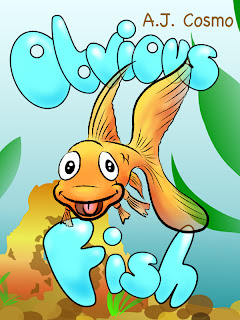Hello everyone!
Sculpture can be a great way to spark the imagination, engage thinking, and relax after a stressful day. Every child loves Play-Doh, but if you'd like something a little more permanent, I'd recommend Sculpey.
Sculpey is a plastic modeling clay that you can bake in the oven to harden. It's extremely soft and maleable and also relatively cheap. It normally comes in white but you can also purchase color blocks like the ones above. (Use a mat or work on an old table, the colors can stain!)
What am I making? An Aarghmouth of course! This little guy is from one of my favorite books
Monsters A to Z. He lives behind things and likes to jump out and scare people.
So how do you go about sculpting something like this? Well you start with a base, or in this case the feet . . .
When sculpting you always go from simple shapes to complex ones. Don't get frustrated if it doesn't look like what it should be immediately, you can always go back and mold it later! Work from bottom to top, that way the sculpture will be balanced when you're done.
I placed the chin and then cut in to the feet to carve them out. They look so cute!
I used the red clay to create the back of the mouth and then covered it with a thin layer of orange (I was running out of orange already!) Not only do you want to work bottom to top, you also want to work inside to out, so we have to create the mouth cavity first. Now on to the teeth!
I inserted the teeth and then covered it with a wedge of orange to create the top of the jaw. Now it gets tricky. One of the hardest things to do in sculpture is free floating appendages. The trick is to make the base sturdy and the extension delicate.
I made the hand separately just by using a ball and three rolls. I attached the arm by spreading the Sculpy over itself. As long as you mush together all of the sides, the piece should bond together.
You can press in to the center of your sculpture to get it to balance, but this one was being tricky. So I had to improvise . . .
I added a tail. Sometimes you have to take liberties in order to make a project work. Be fearless! Now for the eyes . . .
Make sure the base is secure and remember your process. Everything takes little steps and as long as you think things through, you will have success!
I mixed yellow with red to get the pink and then inserted the uvula and tongues after molding them. All it took to attach them was pressing them in.
Use a small round or flat object to smooth out fingerprints and places where you bonded the Sculpy. (I used a cuticle pusher!) Other household tools include toothpicks and spoons.
Voila! Now it's time to bake :)
(Definitely need parental supervision for this!)
Preheat the oven to 275 degrees Fahrenheit. Then bake the Sculpey for 15 minutes per 1/4 inch thickness. This little guy is about one inch thick, so I set the timer for 60 minutes.
Poor fella. He looks terrified! Sculpy can burn so it's importnat to watch the time. It also has a distinct smell when it's done, sort of a woody plastic smell. When the smell turns bad, like a burned pizza, remove it quickly!
What kind of things will your children create? Send me pictures of your creations
@ajcosmokids and I'll post them!


















.JPG)






.JPG)


.JPG)

.JPG)
.JPG)











